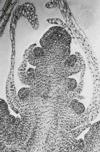- meristem
-
/mer"euh stem'/, n. Bot.embryonic tissue in plants; undifferentiated, growing, actively dividing cells.[1870-75; < Gk merist(ós) divided, distributed (equiv. to *merid-, s. of merízein to divide into parts (deriv. of méris part, share) + -tos v. adj. suffix) + -em < Gk -ema termination of nouns denoting result of action; cf. -EME]
* * *
In plants, region of cells capable of division and growth.Meristems are classified by location as apical, or primary (at root and shoot tips), lateral, or secondary (in the vascular cambium and cork cambium), or intercalary (at internodes, stem regions between the places at which leaves attach, and at leaf bases, especially in certain monocots, e.g., grasses). Apical meristems give rise to the primary plant body. Lateral meristems provide increase in stem girth. Injured tissues can convert other cells to new meristem for wound healing. MeristemJ.M. Langham
MeristemJ.M. Langham* * *
▪ plant anatomyregion of cells capable of division and growth in plants. Meristem cells are typically small cells the diameters of which in different directions are about equal. They have a dense cytoplasm and relatively few small vacuoles (watery saclike enclosures).Meristems are classified by their location in the plant as apical (located at root and shoot tips), lateral (in the vascular and cork cambia), and intercalary (at internodes, or stem regions between the places at which leaves attach, and leaf bases, especially of certain monocotyledons—e.g., grasses). Apical meristems are also known as primary meristems because they give rise to the primary plant body. Lateral meristems are secondary meristems because they are responsible for secondary growth, or increase in stem girth and thickness. Meristems form anew from other cells in injured tissues and are responsible for wound healing.* * *
Universalium. 2010.
